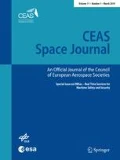It is an honour and a great pleasure for us to present this special issue of the CEAS Space Journal devoted to the development of large deployable antennas and related technologies.
Large deployable antennas for space applications have been under development worldwide for several decades, driven by both mission performance enhancement goals as well as mission enabling goals. Developments in ESA started already in the 80s with a 5-m metal-mesh reflector built by MBB/ERNO in Germany, continued later with a 10-m inflatable reflector built by Contraves in Switzerland and more recently a 12-m antenna built by Thales Alenia Space in Italy. However, for various reasons all these developments did not result in a final available European antenna reflector product. As a matter of fact, today there is no European antenna reflector product larger than 4 m aperture available, forcing European spacecraft developers to procure large reflectors from non-European sources.
Three years ago, an ESA Working Group on large reflector antennas was set up with the mandate to define recommendations on how to proceed with new large reflector developments in Europe. Several spacecraft missions in need of antenna reflectors were identified, including well-established telecommunication markets such as fixed and broadcasting satellite services, mobile interactive/broadcast services, broadband services, but also new applications such as air traffic management and emergency communications. These missions cover the frequency spectrum up to Ka-band. Synergies with Earth Observation, Navigation and Scientific deep space missions were also identified.
One of the main conclusions of the Working Group was that near-term effort should be devoted to the development of technologies for reflectors with scalability and/or modularity features to cover sizes above 4 m and up to 25 m for frequency bands ranging from P to Ka. It was understood that many of the technologies were in fact available or within reach, and the missing task of coordination and industrial implementation was considered achievable.
In October 2012, the first Large Deployable Antenna Workshop took place at ESA/ESTEC, The Netherlands, with a significant participation from European industry and research organisations. During this workshop, several recent technology developments for large antenna reflectors were presented and discussed together with a new reflector deployment demonstration.
The workshop addressed as well developments for in-flight reconfigurability of space antennas using reflector reshaping that is finally becoming technically feasible after many years of trials. Reflect-arrays and lenses were also addressed, as well as radio frequency testing, especially relevant due to the challenges ahead of us for the development of test facilities required for large apertures.
This special issue of the CEAS Space Journal is intended to present the key technologies addressed in this workshop. A second edition of the workshop is under preparation for 2014 with the objective to report on the major developments performed over the last 2 years.
Last but not least, we would like to convey a very special thank you to Dr. C. Stavrinidis, the Editor-in-Chief and Head of the Mechanical Engineering Department of ESA; Ms. C. Signorini, the Head of the Electrical Engineering Department of ESA; Dr. W. Kordulla, the Managing Editor; and Springer for making the special issue possible.
T. K. Henriksen, Space Journal Editor “Structures”
C. Mangenot
Author information
Authors and Affiliations
Corresponding author
Rights and permissions
About this article
Cite this article
Henriksen, T.K., Mangenot, C. Large deployable antennas. CEAS Space J 5, 87–88 (2013). https://doi.org/10.1007/s12567-013-0055-4
Published:
Issue Date:
DOI: https://doi.org/10.1007/s12567-013-0055-4

